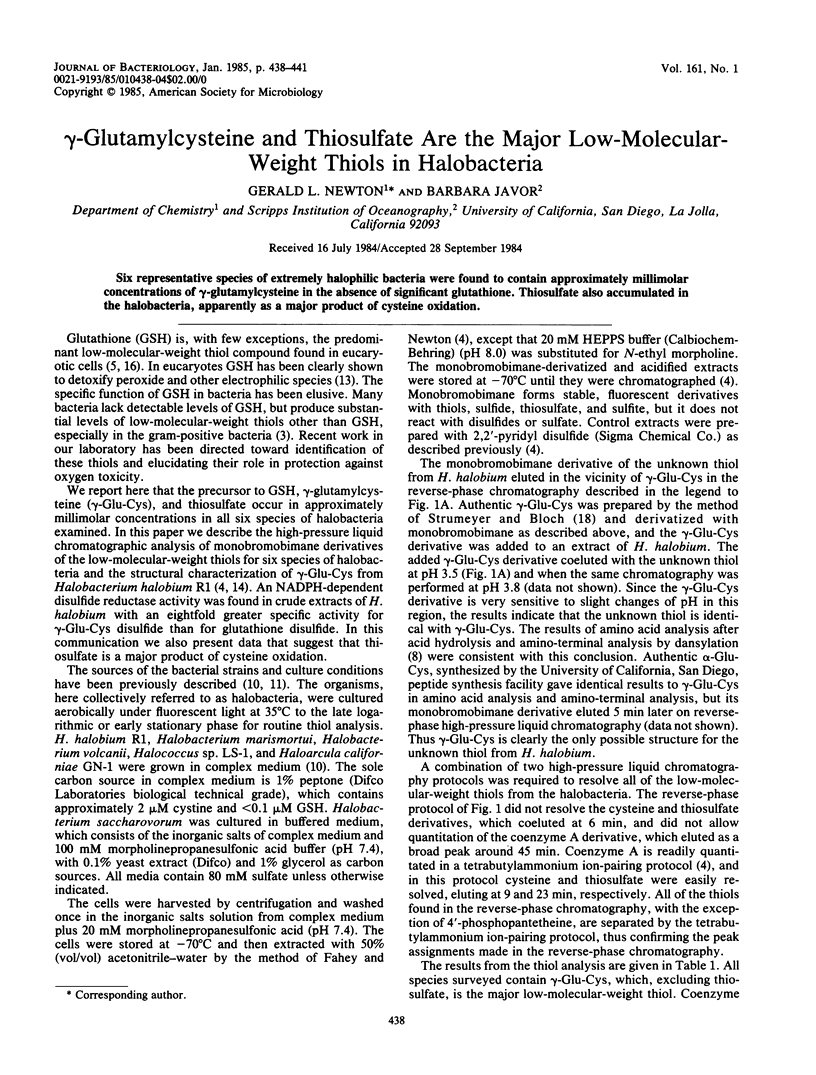Abstract
Six representative species of extremely halophilic bacteria were found to contain approximately millimolar concentrations of gamma-glutamylcysteine in the absence of significant glutathione. Thiosulfate also accumulated in the halobacteria, apparently as a major product of cysteine oxidation.
Full text
PDF



Selected References
These references are in PubMed. This may not be the complete list of references from this article.
- Apontoweil P., Berends W. Isolation and initial characterization of glutathione-deficient mutants of Escherichia coli K 12. Biochim Biophys Acta. 1975 Jul 14;399(1):10–22. doi: 10.1016/0304-4165(75)90206-8. [DOI] [PubMed] [Google Scholar]
- Fahey R. C., Brown W. C., Adams W. B., Worsham M. B. Occurrence of glutathione in bacteria. J Bacteriol. 1978 Mar;133(3):1126–1129. doi: 10.1128/jb.133.3.1126-1129.1978. [DOI] [PMC free article] [PubMed] [Google Scholar]
- Fahey R. C., Newton G. L., Arrick B., Overdank-Bogart T., Aley S. B. Entamoeba histolytica: a eukaryote without glutathione metabolism. Science. 1984 Apr 6;224(4644):70–72. doi: 10.1126/science.6322306. [DOI] [PubMed] [Google Scholar]
- Fox G. E., Stackebrandt E., Hespell R. B., Gibson J., Maniloff J., Dyer T. A., Wolfe R. S., Balch W. E., Tanner R. S., Magrum L. J. The phylogeny of prokaryotes. Science. 1980 Jul 25;209(4455):457–463. doi: 10.1126/science.6771870. [DOI] [PubMed] [Google Scholar]
- Fuchs J. A., Warner H. R. Isolation of an Escherichia coli mutant deficient in glutathione synthesis. J Bacteriol. 1975 Oct;124(1):140–148. doi: 10.1128/jb.124.1.140-148.1975. [DOI] [PMC free article] [PubMed] [Google Scholar]
- Griffith O. W., Meister A. Potent and specific inhibition of glutathione synthesis by buthionine sulfoximine (S-n-butyl homocysteine sulfoximine). J Biol Chem. 1979 Aug 25;254(16):7558–7560. [PubMed] [Google Scholar]
- Javor B. J. Growth potential of halophilic bacteria isolated from solar salt environments: carbon sources and salt requirements. Appl Environ Microbiol. 1984 Aug;48(2):352–360. doi: 10.1128/aem.48.2.352-360.1984. [DOI] [PMC free article] [PubMed] [Google Scholar]
- Javor B., Requadt C., Stoeckenius W. Box-shaped halophilic bacteria. J Bacteriol. 1982 Sep;151(3):1532–1542. doi: 10.1128/jb.151.3.1532-1542.1982. [DOI] [PMC free article] [PubMed] [Google Scholar]
- Meister A., Anderson M. E. Glutathione. Annu Rev Biochem. 1983;52:711–760. doi: 10.1146/annurev.bi.52.070183.003431. [DOI] [PubMed] [Google Scholar]
- Newton G. L., Dorian R., Fahey R. C. Analysis of biological thiols: derivatization with monobromobimane and separation by reverse-phase high-performance liquid chromatography. Anal Biochem. 1981 Jul 1;114(2):383–387. doi: 10.1016/0003-2697(81)90498-x. [DOI] [PubMed] [Google Scholar]
- Ondarza R. N., Rendón J. L., Ondarza M. Glutathione reductase in evolution. J Mol Evol. 1983;19(5):371–375. doi: 10.1007/BF02101641. [DOI] [PubMed] [Google Scholar]
- PRICE C. A. A new thiol in legumes. Nature. 1957 Jul 20;180(4577):148–149. doi: 10.1038/180148a0. [DOI] [PubMed] [Google Scholar]
- SORBO B. Enzymic transfer of sulfur from mercaptopyruvate to sulfate or sulfinates. Biochim Biophys Acta. 1957 May;24(2):324–329. doi: 10.1016/0006-3002(57)90201-9. [DOI] [PubMed] [Google Scholar]
- Tuttle J. H., Holmes P. E., Jannasch H. W. Growth rate stimulation of marine pseudomonads by thiosulfate. Arch Microbiol. 1974;99(1):1–14. doi: 10.1007/BF00696218. [DOI] [PubMed] [Google Scholar]


